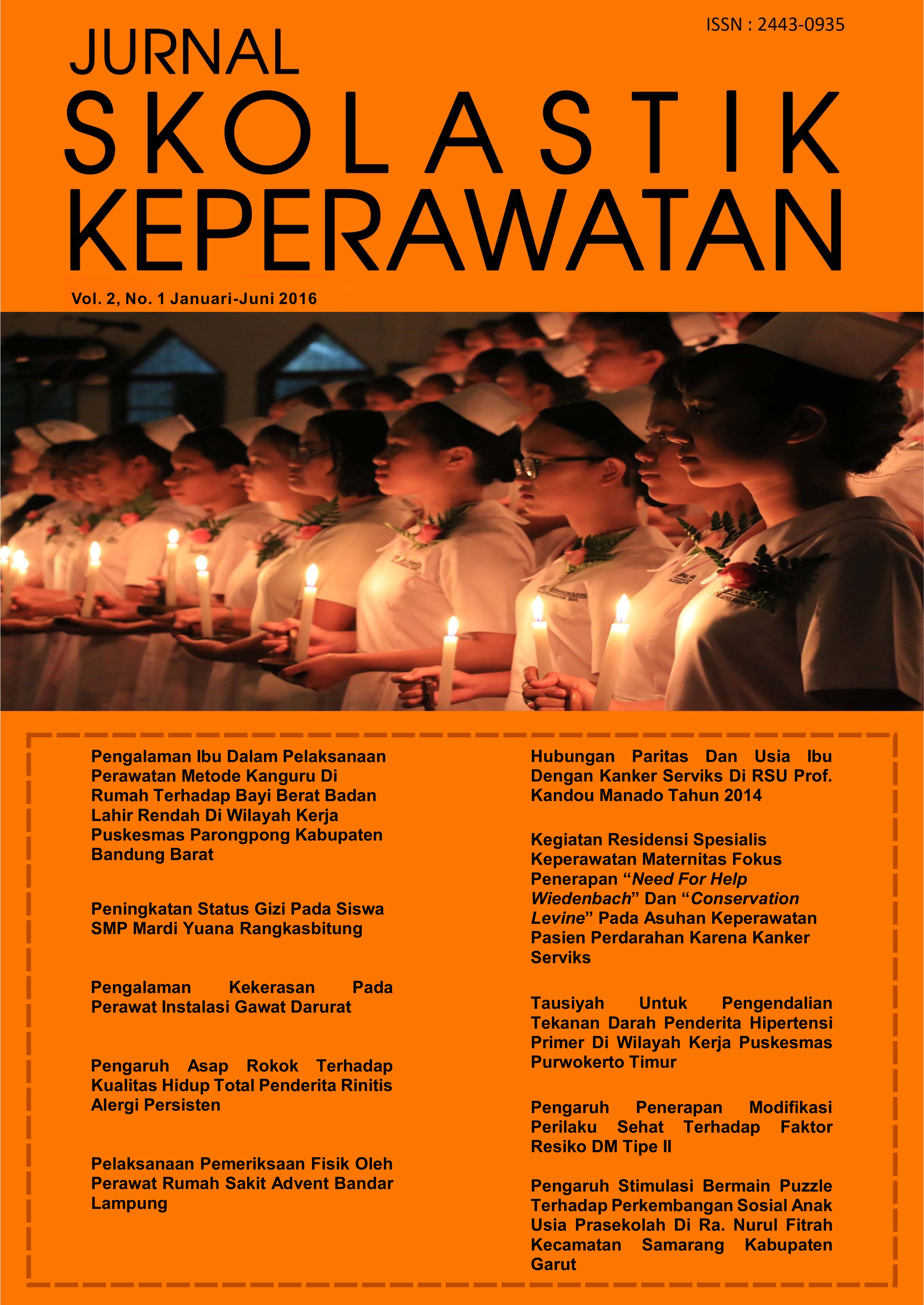PENGALAMAN KEKERASAN PADA PERAWAT INSTALASI GAWAT DARURAT
Kata Kunci:
libraries, publishing, research servicesAbstrak
ABSTRAK
Pendahuluan: Hasil wawancara peneliti dengan lima perawat Instalasi Gawat Darurat menunjukkan semua perawat mengatakan pernah mengalami kekerasan secara verbal dari pasien maupun perawat. Penelitian ini untuk mendapatkan gambaran pengalaman kekerasan dan cara perawat menyikapi tindak kekerasan
yang terjadi. Metode: Penelitian ini menggunakan metode kualitatif fenomenologi dengan teknik in-depth interview dan sampel dipilih dengan menggunakan metode purposive sampling sampai  data yang didapatkan jenuh. Analisis yang digunakan adalah analisis menurut Colaizzi (1978). Hasil: Penelitian ini mempunyai enam tema yaitu Pelaku verbal Bullying terhadap perawat, ekspektasi orang lain yang tidak dapat dipenuhi oleh perawat, mekanisme koping yang dilakukan perawat saat menghadapi tindak kekerasan, dukungan yang didapatkan perawat saat menghadapi tindakan kekerasan, respon perawat terhadap tindakan keker asan, presepsi perawat terhadap tindakan kekerasan. Diskusi: Penelitian ini perlu sikap dan tanggapan yang positif dari perawat dan institusi rumah sakit terhadap perilaku bullying di ruang Instalasi.
ABSTRACT
Introduction: The result of research interviews with five emergency department nurses showed all the nurses said they had been verbal bullying and there was one nurse who had experienced physical violence from patients and nurses. The purpose of this study to get an overview of the experience of violence and how nurses address the violence. Method: This study used qualitative methods phenomenology with in-depth interview technique and the sample was selected using purposive sampling method to data obtained saturated. Analysis used the analysis by Colaizzi (1978). Results: This research has six themes, namely Perpetrators of verbal bullying against nurses, the expectations of others that can not be filled by nurses, coping mechanisms do nurses in the face of violence, the support obtained nurse in the face of violence, the response of nurses to acts of violence, the perception of nurses against acts of violence. Discussion: from this research should be the attitude and positive responses from nurses and hospital institutions against bullying behavior in the emergency room.
Unduhan
Referensi
Ahmed, A. S. (2012). Verbal and Physical Abuse against Jordanian Nurses in the work environment. Eastern Mediterranean Health Journal 18(4), 318-324
Clark, C. (2009). Creative Nursing Leadership & Management Minessota: Jones and Barlett.
Darawad, M.W; Al-Hussami, M; Saleh, A.M; Mustafa, W.H. dan Odeh. H (2015). Violence Against Nurses in Emergency Departments in Jordan: Nurses Perspective. Journal Permissions.nav, vol 63 (1), 9-17 Http://aplications.emro.who.it/emhj/v18/04/18_4_2012_0318_0324.pdf?ua=1.
Emergency Nurses Association. (2011, November). Emergency Department Violence Surveillance Study. Institute for Emergency Nursing Research., 1-60, November 2011. https://www.ena.org/.../ENAEDVSReportNovember2011.pdf
Gacki-Smith, J., Juarez, A. M., Boyett, L., Homeyer, C., Robinson, L., dan MacLean, S. L. (2010). Violence against nurses working in US emergency departments. Journal of Healthcare Protection Management : Publication of the International Association for Hospital Security, 26 (1), 81–99. http://doi.org/10.1097/NNA.0b013e3181ae97db
Gates, D. M; Gillespie, G. L., Succop, P. (2011). Violence Against Nurses and its impact on stress and productivity. CNE series, 29 (2), 59–68, March- April 2011.
Howerton, C. dan Rebekah, J. (2013). Appraisal, Coping, Social Support, Perceived Patient Safety and Intent to Leave in Emergency Department RNs Who Have Experienced Workplace Violence. Los Angeles. University of California. (Disertasi) http://doi.org/10.1016/j.anr.2011.11. 001
Kennedy, M. dan Julie, H. (2013). Nurses’ experiences and understanding of workplace violence in a trauma and emergency department in South Africa. Health SA Gesondheid 18 (1), 1–9.
Thomas, C. M; Mcintosh, C. E. dan Mensik, J. S. (2016). A Nurses's Step by Step Guide to Transitioning to the Professional Nurse Role. USA: Sigma ThetaTau International. http://doi.org/10.4102/hsag.v18i1.663
National Advisor y Council on Nurse Education and Practice. (2007, Desember). Violence Against Nurses, fifth report. U.S Department of Health and Human Services. United States.
Onweuegbuzie, A.J. dan Leech, N.L. (2007). Sampling desain in Qualitative Research: Making the Sampling Process More Public. The Qualitative Report 12, 238-254.
Robinson, R. B. (2004). The Relationship Among Emergency Room Nurses' Preceptions of Violence, Occupational Stress, and Coping. Birmingham. University of Alabama. (Disertasi)
Stanley, A. E. (2008). Emergency Department Nurses' Experience and Preception of Workplace Violence. Highland Heights Northern Kentucky University. (Tesis)
Talas, M. S; Kocaöz, S. & Akgüç, S. (2011). A Survey of Violence Against Staff Working in the Emergency Department in Ankara, Turkey. Asian Nursing Research, 5 (4), 197–203.
Thomas, S. P. (2009). Transforming Nurses' Stress and Anger Steps Toward Healing. 3rd edition. New York: Springer Publishing Company.
##submission.downloads##
Diterbitkan
Cara Mengutip
Terbitan
Bagian
Lisensi
Hak Cipta (c) 2021 Michelle Christlevica, Gilny Aileen Joan, Denny Ricky

Artikel ini berlisensiCreative Commons Attribution-NonCommercial-ShareAlike 4.0 International License.
Penulis yang mempublikasikan naskahnya di jurnal ini menyetujui hal-hal berikut:
- Hak cipta tetap pada penulis, penulis memberikan kepada jurnal hak penerbitan pertama dan sekaligus melisensi karyanya mengikuti Creative Commons Attribution License yang mengizinkan orang lain untuk berbagi karya dengan penghargaan terhadap hak kepenulisan dan penerbitan pertama di jurnal ini.
- Penulis bisa mengikuti kontrak tambahan lain untuk distribusi non-ekslusif bagi karyanya tersebut (contoh: mempostingnya ke repositori institusi atau menerbitkannya dalam sebuah buku), dengan penghargaan terhadap penerbitan pertama di jurnal ini.
- Penulis diizinkan dan didorong untuk mem-posting karya mereka online (contoh: di repositori institusi atau di website mereka) sebelum dan selama proses penyerahan, karena dapat mengarahkan ke pertukaran produktif, seperti halnya sitiran yang lebih awal dan lebih banyak dari karya yang diterbitkan. (Lihat The Effect of Open Access).








